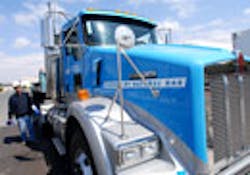Incentives fueling natural gas vehicle usage
A recent study of government and private fleets operating in the New York metropolitan area finds that financial incentives are critical to boosting their acquisition and use of natural gas vehicles (NGVs).
Yet the study – conducted by independent consulting firm Emisstar LLC on behalf of the trade group Natural Gas Vehicles for America (NGV America) – also determined to function effectively, incentive programs need to tie vehicle funding directly to emission reductions, with fleets refunding money if they do not reach certain emission targets, while also allowing fleets to gain maximum resale value from the diesel and gasoline vehicles being replaced.
“Recommendations for incentive grant amounts should be based upon actual emissions reductions achieved, focusing on particulate matter (PM) reduction cost effectiveness – a benchmark industry metric,” the report said. “Cost-effectiveness is a commonly used statistic to compare how well a project achieves emissions goals per dollar. It is anticipated that a new NGV incentive program yields average cost effectiveness of $273,000 to $365,000 per ton of PM reduced, which is comparable to other incentive grant programs.”
For the New York metro area alone, then, Emisstar said its replacement vehicle calculations would require an NGV incentive program with an initial funding pool of $10 million.
The report suggests incorporating specific incentive program eligibility and commitment requirements to ensure that emissions reductions are real, significant and surplus, including:
- Eligible trucks must have been owned and operated in the target region for the past 2 years,
- Eligible trucks must be Class 6 and higher,
- Newer, replacement truck must be operated in target region for 7 years,
- At least 75% of mileage driven must be within designated nonattainment area,
- Annual mileage cannot exceed 130% of historical mileage from previous 2 years,
- GPS [global positioning systems] should be installed and remain operational for 7 years,
- Older truck must be scrapped or permanently removed from state and nonattainment regions, and
- If usage commitments are not met for the new truck, applicant may be required to pay back a prorated amount of the grant.
Emisstar’s research also noted that re-consideration of typical scrapping requirements may be necessary for highly specialized fleets such as those serving the solid waste industry as they have a fairly high resale values in the used truck market.
“To promote more vigorous participation with private sector fleet operators, new programs may want to consider allowing participants with these vehicles the option to scrap or to permanently transfer them out of state,” the study noted. “Also, when determining potential grant amounts, using fuel consumption rather than annual mileage to more accurately account for vehicle impact. Solid waste fleets, for example, operate almost extensively stop-and-go operation in urban areas, with frequent idling.”
“Our aim with this study was to analyze existing incentive-based emissions reduction approaches nationwide, and to recommend how a regional NGV financial incentive program could be developed and implemented in the New York [city] area,” noted Glenn Goldstein, Emisstar’s principle.
“We hope demonstrate the feasibility of implementing a voluntary natural gas vehicle incentive program that is attractive to business and public interest alike,” he added.
The Emisstar Natural Gas Vehicle Incentive Program Report is available for downloading at no charge at www.emisstar.com.
About the Author
Sean Kilcarr
Editor in Chief
Sean Kilcarr is a former longtime FleetOwner senior editor who wrote for the publication from 2000 to 2018. He served as editor-in-chief from 2017 to 2018.
